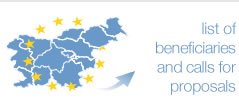Closure of project Library for the blind and visually impaired: Library for next generations
“These days the Slovenian Association of the Blind and Visually Impaired has numerous reasons for celebration. On 7 November the Association, which is the oldest Slovenian impairment-specific organisation, marked its 95th anniversary; the end of this month will also mark the closure of the project Library for the blind and visually impaired which is one of the most important projects of our Association of this decade. The value of the achieved results is of immense value for the Association and its members” said Tomaž Wraber, president of the Slovenian Association of the Blind and Visually Impaired, and added “We should not overlook the wider impact of the project on the social environment. We got an opportunity to open our doors, introduce ourselves to the wider public and thus actively participate in building bridges and overcoming taboos related to blindness and visual impairment”.
The project was implemented in the framework of Operational Programme for Human Resources Development for the Period 2007-2013, priority axis “Equal opportunities and reinforcing social inclusion”. According to the Director of the Cohesion Policy Office at the Government Office for Development and European Cohesion Policy Bojan Suvorov, MSc, Slovenia was very successful in EU funds absorption in this field. “Over 60 million euros was paid from the national budget to programmes targeting vulnerable groups and I expect a 100% absorption rate by the end of 2015 when the programming period is coming to a close. I am very pleased that the numerous projects receiving EU funds support have contributed to combating any discrimination and to reinforcing equal opportunities. The project Library for the blind and visually impaired is indeed an example of best practice in this field.” He underlined that in the framework of the new financial perspective 2014-2020 EUR 220 million will be allocated to projects and programmes relating to social inclusion and reducing poverty risk. “European Social Funds will be spent for active inclusion, including promotion of equal opportunities and active cooperation, as well as improving employability, healthcare and social services, promoting social inclusion and easier access to social, cultural and recreational services, and promoting social entrepreneurship and inclusive economy to facilitate access to employment.”
Presentation of the project The project can be divided into five key sets. The first set introduced new expert bases for the operation of the Minka Skaberne Library for the blind and visually impaired. The second set focused on enhanced production of library material in Braille and audio library material. A new format of audiobooks was introduced in Slovenia, namely the format DAISY which differs from the mp3 format in light of the fact that it enables structured reading, namely moving between pages and chapters. Three newspapers were published in the framework of the project – a newspaper in Braille (published every three months), a newspaper in large print and an audio newspaper (published once a month). The third set covered education-related content targeting the blind and visually impaired as well as experts and the general public. The fourth set focused on upgrading the IT system ZDSSS (EIS). The fifth set is the most visible set – in its framework new premises for the Minka Skaberne Library for the blind and visually impaired were rented and renovated; the firth set also covered various promotional and cultural activities. “The project gave employment to 9 blind or visually impaired and for the majority of the newly-employed this was their first employment. Minka Skaberne Library for the blind and visually impaired got 120 new members, training courses were attended by 400 blind or visually impaired people as well as 500 practitioners. The project also results in 365 additional audiobooks and 35 books in Braille, and in the development of a new modern speech synthesizer for the Slovenian language called “eBralec” (eReader)” as Tilen Škraba, the operational project manager, summarised project results.
Speech synthesizer eBralec is a result of cooperation between research organisations and two Slovenian language-technological companies sharing their knowledge in the field of processing speech signals and language data. “eBralec enables automatic reading of various electronic texts in Slovene. The quality of the new speech synthesis is really at a high level as it comes very close to natural speech even though written text is transformed into speech automatically” said dr. Jerneja Žganec Gros, representative of the company Alpineon d.o.o., and Miro Robih, representative of the company Amebis d.o.o., which participated in the development of the speech synthesizer. eBralec will make computer work and dealing with smart phones using Android systems much easier for the blind and visually impaired, it will also facilitate access to news and information and thus improve e-inclusion into modern information society.





